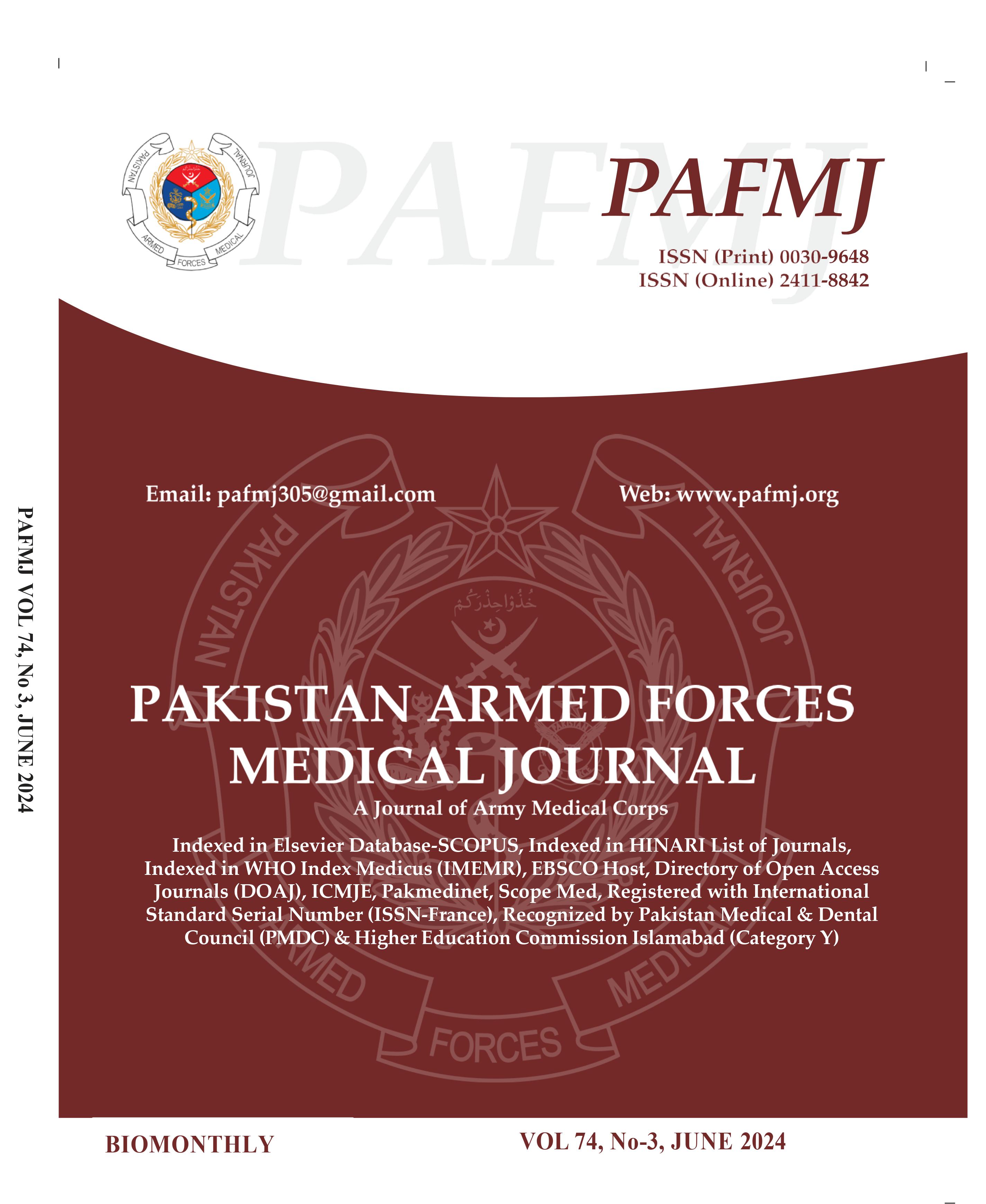Comparison of Outcome of Metformin And Inositol on Hormonal Aspects in Women with Polycystic Ovaries: A Quasi-Experimental Study
DOI:
https://doi.org/10.51253/pafmj.v74i3.9971Keywords:
Inositol, Metformin, polycystic ovarian diseaseAbstract
Objective: To individually assess the role of Metformin and Inositol in dealing with hormonal problems in terms of serum Luteinizing Hormone/ Follicular stimulating hormone ratio, serum prolactin and serum progesterone in females with polycystic ovarian disease over a period of one year.
Study Design: Quasi-experimental study.
Place and Duration of Study: Department of Gynaecology and Obstetrics, PAF Hospital Islamabad Pakistan, from Jul 2020 to Jul 2021.
Methodology: Patients (n=80) presenting with OPD were divided into two equal groups and followed over a period of six months. Group-A was given Tab Inositol 4g once daily, and Group-B was given Tab Metformin 500 mg three times daily. Over a period of three to six months, Metformin and Inositol were used to compare biochemical parameters such as serum Luteinizing Hormone/ Follicular stimulating hormone ratio, serum prolactin, and serum progesterone.
Results The results showed that Inositol has better results in terms of hormonal aspects, with a mean Luteinizing Hormone/ Follicular stimulating hormone ratio of 2.55±0.02 at 6 months. At three and six months, the mean serum prolactin and mean serum progesterone were comparable in both groups.
Conclusion: Inositol has a better impact on hormonal aspects in women with polycystic ovarian disease by improving patients’ biochemical profiles.
Downloads
References
Wolf WM, Wattick RA, Kinkade ON, Olfert MD. Geographical Prevalence of Polycystic Ovary Syndrome as Determined by Region and Race/Ethnicity. Int J Environ Res Public Health 2018 ; 15(11): 2589. https://doi.org/10.3390/ijerph15112589
Fornes R, Simin J, Nguyen MH, Cruz G, Crisosto N, van der Schaaf M, et al. Pregnancy, perinatal and childhood outcomes in women with and without polycystic ovary syndrome and metformin during pregnancy: a nationwide population-based study. Reprod Biol Endocrinol 2022 ; 20(1): 30. https://doi.org/10.1186/s12958-022-00905-6
Guo F, Gong Z, Fernando T, Zhang L, Zhu X, Shi Y. The Lipid Profiles in Different Characteristics of Women with PCOS and the Interaction Between Dyslipidemia and Metabolic Disorder States: A Retrospective Study in Chinese Population. Front Endocrinol 2022; 13: 892125
. https://doi.org/10.3389/fendo.2022.892125
Kalaivani V, Gopalan U. Metabolic syndrome in polycystic ovary syndrome: a review. Int J Reprod Contracept Obstet Gynecol 2021; 10: 1247-1250. https://doi.org/10.18203/2320-1770.ijrcog20210775
Sangaraju SL, Yepez D, Grandes XA, Talanki Manjunatha R, Habib S. Cardio-Metabolic Disease and Polycystic Ovarian Syndrome (PCOS): A Narrative Review. Cureus 2022 ; 14(5): e25076. https://doi.org/10.7759/cureus.25076
Szczuko M, Kikut J, Szczuko U, Szydłowska I, Nawrocka-Rutkowska J, Ziętek M, et al. Nutrition Strategy and Life Style in Polycystic Ovary Syndrome-Narrative Review. Nutrients 2021; 13(7): 2452. https://doi.org/10.3390/nu13072452
Morgante G, Massaro MG, Di Sabatino A, Cappelli V, De Leo V. Therapeutic approach for metabolic disorders and infertility in women with PCOS. Gynecol Endocrinol 2018 ; 34(1): 4-9. https://doi.org/10.1080/09513590.2017.1370644
Gambioli R, Montanino Oliva M, Nordio M, Chiefari A, Puliani G, Unfer V. New Insights into the Activities of D-Chiro-Inositol: A Narrative Review. Biomedicines 2021 ; 9(10): 1378. https://doi.org/10.3390/biomedicines9101378
Facchinetti F, Unfer V, Dewailly D, Kamenov ZA, Diamanti-Kandarakis E, et al; Group of 'Inositol in PCOS and Reproduction'. Inositols in Polycystic Ovary Syndrome: An Overview on the Advances. Trends Endocrinol Metab 2020 ; 31(6): 435-447. https://doi.org/10.1016/j.tem.2020.02.002
Greff D, Juhász AE, Váncsa S, Váradi A, Sipos Z, Szinte J, et al. Inositol is an effective and safe treatment in polycystic ovary syndrome: a systematic review and meta-analysis of randomized controlled trials. Reprod Biol Endocrinol 2023 ; 21(1): 10. https://doi.org/10.1186/s12958-023-01055-z
Nabi S, Guleria R. Comparison of Myoinositol and Metformin in Women with Polycystic Ovarian Syndrome. Asian J Diabetol 2020; 21(2), 17–24.
Naz MSG, Tehrani FR, Majd HA, Ahmadi F, Ozgoli G, Fakari FR, Ghasemi V. The prevalence of polycystic ovary syndrome in adolescents: A systematic review and meta-analysis. Int J Reprod Biomed 2019 ; 17(8): 533-542.
https://doi.org/10.18502/ijrm.v17i8.4818
Kriedt KJ, Alchami A,Davies MC.PCOS: diagnosis and management of related infertility. Obstet Gynaecol Reprod Med 2019; 19: 1–5.
Sadeghi HM, Adeli I, Calina D, Docea AO, Mousavi T, Daniali M, et al. Polycystic Ovary Syndrome: A Comprehensive Review of Pathogenesis, Management, and Drug Repurposing. Int J Mol Sci 2022 ; 23(2): 583.https://doi.org/10.3390/ijms23020583
Davinelli S, Nicolosi D, Di Cesare C, Scapagnini G, Di Marco R. Targeting Metabolic Consequences of Insulin Resistance in Polycystic Ovary Syndrome by D-chiro-inositol and Emerging Nutraceuticals: A Focused Review J Clin Med 2020 ; 9(4): 987. https://doi.org/10.3390/jcm9040987
Amisi CA. Markers of insulin resistance in Polycystic ovary syndrome women: An update. World J Diabetes 2022 ; 13(3): 129-149. https://doi.org/10.4239/wjd.v13.i3.129
Thalamati S. A comparative study of combination of Myo-inositol and D-chiroinositol versus Metformin in the management of polycystic ovary syndrome in obese women with infertility. Int J Reprod Contracept Obstet Gynecol 2019; 8: 825-829.https://doi.org/10.18203/2320-1770.ijrcog20190498
Vyas L, Raiturkar AP,Sud S, Goyyal P, Abhyankar M, Revankar S, et al. Management of polycystic ovary syndrome among Indian women using Myo-inositol and D-chiro-inositol. Bioinformation 2022 ; 18(2): 103-
https://doi.org/10.6026/97320630018103
Nas K, Tűű L. A comparative study between myo-inositol and metformin in the treatment of insulin-resistant women. Eur Rev Med Pharmacol Sci 2017; 21(2 Suppl): 77-82
Kim JJ, Choi YM. Phenotype and genotype of polycystic ovary syndrome in Asia: Ethnic differences. J Obstet Gynaecol Res 2019; 45(12): 2330-2337.https://doi.org/10.1111/jog.14132
Downloads
Published
Issue
Section
License
Copyright (c) 2024 Namra Mazhar, Ghazala Mahmud, Mazhar Ashfaq, Shakira Tabassum, Amina Akbar, Fatima Idrees

This work is licensed under a Creative Commons Attribution-NonCommercial 4.0 International License.















